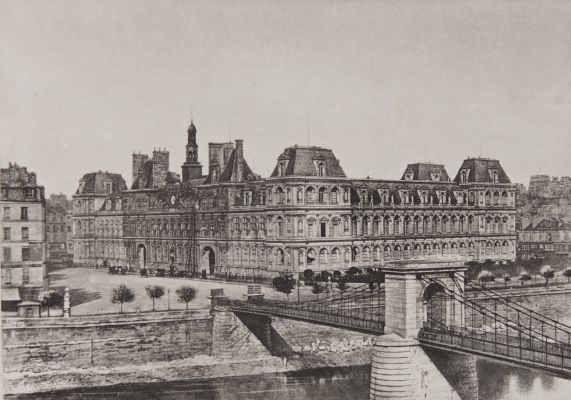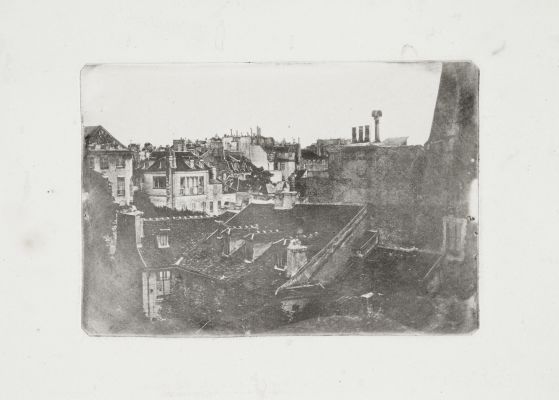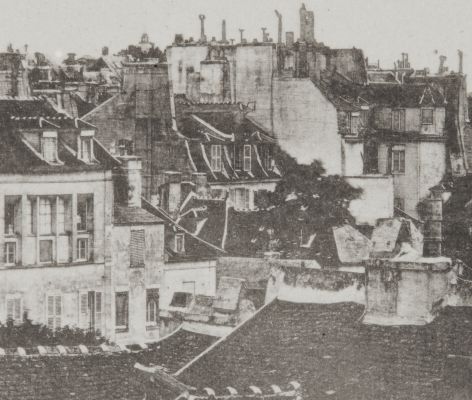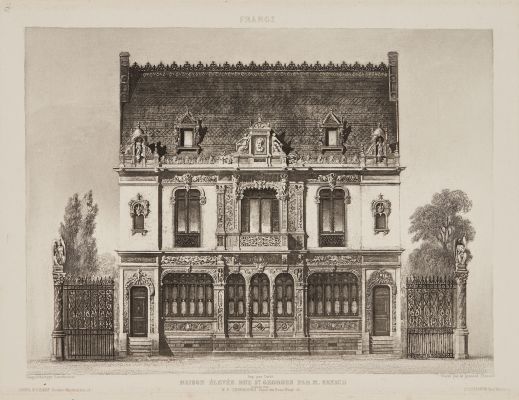
Title
Bas-relief from the Exterior of Notre DameArtist
Fizeau, Louis Armand Hippolyte (French, 1819-1896)Key FigureDate
1843 caProcess
Photogravure (Fizeau process)Atelier
Goupil et VibertImage Size
17.5 x 14 cmSheet Size
36 x 26 cm
As the daguerreotype became a public matter in August 1839, the optician Noël Marie Paymal Lerebours was among the first businessmen to seize the opportunity. The store opened by his adoptive father, Noël Jean Lerebours, in 1789 at Place du Pont-Neuf had long been among the key Parisian addresses for the production and distribution of optical instruments. When the father passed away in the following year, the son took over the well-established business. At that time, Noël Lerebours was only thirty-two years old, and he seems to have decided to make the daguerreotype his main concern. For the young businessman, both aesthetic and commercial interests came together in the daguerreotype. If one is to believe his own words, he accumulated a collection of more than twelve hundred daguerreotypes within just a few months. It would have consisted mostly of views of Paris and sights from different countries. As Marc Antoine Gaudin reported, the collection was a well known attraction in Paris. It might have also convinced the curious crowd gathering in Lerebours’s store to invest what was at the time a considerable sum into the making of their own daguerreotypes.
From 1840 onwards, based on his photographic collection, Lerebours produced a portfolio of engravings that, under the title Excursions Daguerriennes, quickly became a remarkable commercial success. The portfolio’s subtitle makes it clear: this collection of prints aimed at nothing less than the most remarkable views and monuments of the entire world—“les vues et les monuments les plus remarquables du globe.”… The optician Lerebours recognized the opportunity the daguerreotype provided to achieve an image of immediate precision, unaffected by the taste or imagination of a painter or illustrator. What others dismissed as photography’s inherent flaw—being merely mechanical—was of particular interest to Lerebours, in the sense of a mathematical foundation of image production through the apparatus of the camera. For Lerebours’s idea of a collection that compiled “the most remarkable views and monuments in the world,” such limitations were hardly relevant. It was the novel aesthetic value associated with a visual trip around the world that was of interest….
The prints published by Lerebours, over a hundred in all, are evidence of the continuity with which the Excursions Daguerriennes were produced over the years. Against this background, an “Avis aux souscripteurs,” which the editor probably composed in 1841, is all the more notable. The series of installments, it says, had been held up, leading to numerous complaints. But the audience apparently also complained about a certain monotony in the Excursions, both in their content and in their graphic implementation. Lerebours’s customers not only demanded more than city views; they also apparently suggested using lithographs as an additional medium of reproduction, thus enabling a greater diversity of renditions. Lerebours indeed followed this suggestion by including a small number of lithographs in his portfolio. But a real shift in the relationship between photographic plate and graphic reproduction required something different. Was this the actual motive for Lerebours’s address to his subscribers?
It seems that in 1841 the time had come for such a shift in the structure of visual media. In fact, in the fall of 1839, right after the publication of the technological basics for the production of daguerreotype plates, Alfred Donné had started experimenting with photographic plates. He soon succeeded in engraving them so that they could be used as printing plates. Despite vigorous protest from Daguerre, who saw the principles of his invention as being reduced to absurdity, Donné’s example set a precedent. Soon several inventors at once—among them Joseph von Berres, Albrecht Breyer, and William Robert Grove—took up the idea and developed it in different ways. Apart from the experiments of von Berres, who was based in Vienna, those of the French physicist Hippolyte Fizeau were particularly promising.
Only eight days after Fizeau presented his results to the Académie des Sciences in Paris, Lerebours wrote in his letter to the subscribers that he had taken up the physicist’s procedure for the Excursions Daguerriennes. Thus, his clients would actually have been the first ones, outside a small circle of Parisian photo specialists and scientists at the Academy, to inspect an example of the new reproduction technique. Lerebours would eventually produce three such prints after the Procédé de Fizeau. Apart from the bas-relief from Notre-Dame Cathedral in Paris these include a view of the Paris city hall and the Maison Elevée in rue St. Georges. From the point of view of media technologies, these three sheets unquestionably form the most extraordinary panels within the Excursions daguerriennes.
In fact, what Lerebours’s clients got to see here was in question more than ever. The rendition strategies used in this portfolio can be interpreted overall as an exploration of the space that opens up between the daguerreotype and other graphic visual media. In these three examples produced after the Procédé de Fizeau, this space narrows in a dramatic manner, so that finally the two converge on a single point. Incidentally, it was Lerebours himself who, in the fourth edition of his Traité de photographie from 1842, would explain the details of this complicated copying and printing procedure. The results achieved in this manner are of surprisingly varying quality. While what was apparently the earliest rendering of a bas-relief largely lost the fine structure of the daguerreotype it was based on, the two later renderings display a much greater mastery in the application of the procedure.
The mingling of different visual media in Lerebours’s plates raises a question that has lost none of its topicality in the digital age: What, really, is a photograph? [1]
NOTICE TO SUBSCRIBERS
TESTS OF DAGUERREOTYPE TRANSFORMED INTO ENGRAVED BOARDS. — PROCESS BY M. FIZEAU.
Since January we have not published a single sheet of Excursions Daguerriennes; a large number of subscribers having sent us complaints on this subject, we owe them an explanation. Others us asked why we did not admit several genres, which would allow us to contribute to our work a large number of young talented artists; and we were told of the lithograph that would come, we were told, destroy the monotony which always results from a numerous collection of engravings executed by the same process, even if they were all superior. We will respond to this last observation. We will first say that it is difficult to adopt to everyone’s taste, and that having announced aquatint engravings on steel, the request made by a large number of substituting stone for steel, may well not be to the taste of a few other subscribers.
We recognize that in several plates the intelligence of the pencil would have been preferable to the profession of the aquatintist; but is there a single person who has not been fully satisfied with the magnificent boards of Mr. Hurliman, so admired by artists and all true connoisseurs? Moreover, without being exclusive, we believe that any work requires unity, a thought, and we chose aquatints because it is the kind that came closest to most of the models we had to reproduce.
Nevertheless, wanting to prove that we take the opinion into consideration, we decided to insert in our complete collection six lithographs which, we hope, will leave nothing to be desired, because we will entrust some performance to the finest artists. This separate work will allow us to complete our work for the month of December next, which would not have been possible without it; the exclusive supporters of aquatint will wish, we hopefully we absolve ourselves in favor of this cause. Now, we will justify ourselves for the delay in our publication.
For a long time now, people who are concerned with art, those who keep up to date with the news scientists, knew that they were busy transforming daguerreotype prints into engraved plates; But no (mais), although we know all the sagacity of the skillful chemist to whom we already owe gold chloride and brominated water, so many difficulties seemed insurmountable in this enterprise, that no one believed in a success: eight days ago this success became certain, and the results obtained were presented to the Academy of Sciences.
We have thought that the subscribers of Excursions Daguerriennes would be grateful to us for being the first to know about this admirable result, and we had a separate print made of a proof of one of the bas-reliefs of Notre-Dame de Paris.
We ask our subscribers to accept this first specimen, in compensation for the delay that we brought in our post.
N.-P. LEREBOURS.
Our subscribers will notice that the attached sheet was obtained by purely chemical means, and without any artist touch-up; we did not hesitate to present it as it is, believing that we would appreciate the immense resources that a skillful engraver could draw from such a result.
An agreement made with the author of this process authorizes us to use it for the continuation of the Excursions Daguerriennes, and we are from
present able to reproduce by this process the Daguerreotype portraits that will be made in our establishment.
MM. Opticians or provincial publishers who would like to obtain a patent assignment for the said process, are invited to contact Mr. Lerebours free of charge. MM. amateurs who would like to have prints, whether of portrait, monument or landscape, are committed to doing them on a tenth scale; they will want to leave them under iodine, avoiding exposure to light, and send them to us in this state.
(from the text accompanying the published plate roughly translated from french)
ONE OF THE BAS-RELIEFS OF NOTRE-DAME DE PARIS.
DAGUERREOTYPE TEST TRANSFORMED INTO AN ENGRAVED PLATE. – FIZEAU PROCESS.
The marvelous photographic results recently obtained prove that the daguerrean processes have arrived to great perfection. Half of the problem, the most important and the most difficult, remained to be solved, namely: to obtain a number of copies, printed on paper, of the actual image affixed to the plate. Numerous tests, which remained unsuccessful, had made people despair of success, and M. Daguerre himself had judged it impossible.
The new art therefore seemed reduced to limited purpose, when M. Fizeau came to open an immense career for it by bringing this important solution to the learned and artistic world. After long experiences and constant efforts, he succeeded in transforming the Daguerrian trials into veritable plates engraved by nature.
We can imagine the importance and the boundless future of this discovery. Iconographic art will find in this process a skillful, conscientious, and infallible artist. Portraits, monuments, landscapes, paintings, drawings, engravings, lithographs and various prints, everything is his responsibility; he reproduces with equal and admirable fidelity the shapes and values of tones, lights and shadows. Chemistry here replaces engravers and designers. How? ‘Or’ What to struggle with accuracy with an image drawn by the sun? We will have spent long years in laborious studies, and we will have managed to throw a whole on the paper, to give effect to a drawing, to render
near the sky, the sea, the distance, and the foliage. We then had to deliver our work to an engraver trained in patient and interminable studies, which will have to carry it over with strength, skill and talent, on copper, and we will have finally, after so much care and pain combined, a pretty thing, made with taste and art, but reproducing only approximately a drawing which itself only approximates nature. Well ! a man who will have never touched a pencil will get a proof with the daguerreotype, and by means of the chemical preparation by M. Fizeau, will make a perfect engraving of it, which, printed on paper, will reproduce with mathematical accuracy nature caught in the act.
Fortunately, there is one merit that chemistry will never take away from the artist: that of giving nature, which the daguerreotype returns, so to speak inevitably, the life, the feeling and the charm which reveal the genius helped by fertile resources of talent and imagination.
M. Fizeau applied his process to the reproduction of a bas-relief of Notre-Dame de Paris. Pious characters carry the tomb of the Virgin; two Jews who wanted to put their hand there fell deathly and their hands remain attached to the sacred sepulcher. The photographic engraving perfectly captures all the details and even the smallest traces of decay imprinted over the centuries on the stone of the old monument.
This engraving, obtained without any retouching and only by a chemical process, attests to the reality of the discovery. green, and we are pleased to applaud one of the first to the complete success of the persevering efforts of Mr. Fizeau.
Lerebours would eventually produce three such prints after the Procede de Fizeau. Apart from this bas-relief from Notre-Dame Cathedral in Paris. These include a view of the Paris city hall and the Maison Eleveé in rue St. Georges. From the point of view of media technologies, these three sheets unquestionably form the most extraordinary panels within the Excursions daguerriennes. In fact, what Lerebours’s clients got to see here was in question more than ever. The rendition strategies used in this portfolio can be interpreted overall as an exploration of the space that emerged between the daguerreotype and other graphic visual media. In these three examples produced after the Procede de Fizeau, this space narrows in a dramatic manner, so that finally the two converge on a single point. [2] https://gallica.bnf.fr/ark:/12148/btv1b84583748/f109.item http://visualiseur.bnf.fr/CadresFenetre?O=NUMM-2975&M=pagination
References
[1] Siegel, Steffen. "Uniqueness Multiplied: The Daguerreotype and the Visual Economy of the Graphic Arts." Photography and Other Media in the Nineteenth Century / Edited by Nicoletta Leonardi and Simone Natale. (2018): 116-130
[2] roughly translated from the original french – https://gallica.bnf.fr/ark:/12148/btv1b84583748/f9.item.zoom

![[Rooftops, Paris]](https://res.cloudinary.com/markkatzman/image/upload/c_scale,h_400/v1/master/Fizeau_06.jpg)
![[Rooftops, Paris]](https://res.cloudinary.com/markkatzman/image/upload/c_scale,h_400/v1/master/Fizeau_07.jpg)






